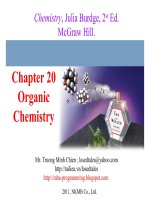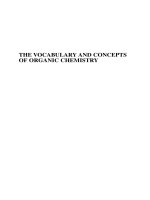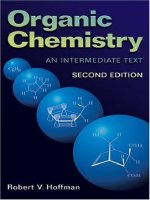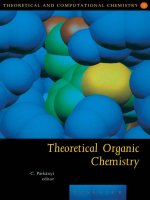organic chemistry an intermediate text
Bạn đang xem bản rút gọn của tài liệu. Xem và tải ngay bản đầy đủ của tài liệu tại đây (3.26 MB, 489 trang )
ORGANIC CHEMISTRY
SECOND EDITION
ORGANIC CHEMISTRY
AN INTERMEDIATE TEXT
SECOND EDITION
Robert V. Hoffman
New Mexico State University
A JOHN WILEY & SONS, INC., PUBLICATION
Copyright 2004 by John Wiley & Sons, Inc. All rights reserved.
Published by John Wiley & Sons, Inc., Hoboken, New Jersey.
Published simultaneously in Canada.
No part of this publication may be reproduced, stored in a retrieval system, o r transmitted in
any form or by any means, electronic, mechanical, photocopying, recording, scanning, or
otherwise, except as permitted under Section 107 or 108 of the 1976 United States Copyright
Act, without either the prior written permission of the Publisher, or authorization through
payment of the appropriate per-copy fee to the Copyright Clearance Center, Inc., 222
Rosewood Drive, Danvers, MA 01923, 978-750-8400, fax 978-750-4470, or on the web at
www.copyright.com. Requests to the Publisher for permission should be addressed to the
Permissions Department, John Wiley & Sons, Inc., 111 River Street, Hoboken, NJ 07030,
(201) 748-6011, fax (201) 748-6008, e-mail:
Limit of Liability/Disclaimer of Warranty: While the publisher and author have used their
best efforts in preparing this book, they make no representations or warranties with respect to
the accuracy or completeness of the contents of this book and specifically disclaim any
implied w arranties of merchantability or fitness for a particular purpose. No warranty may be
created or extended by sales representatives or written sales materials. The advice and
strategies contained herein may not be suitable for your situation. You should consult with a
professional where appropriate. Neither the publisher nor author shall be liable for any loss
of profit or any other commercial damages, including but not limited to special, incidental,
consequential, or other damages.
For general information on our other products and services please contact our Customer Care
Department within the U.S. at 877-762-2974, outside the U.S. at 317-572-3993 or
fax 317-572-4002.
Wiley also publishes its books in a variety of electronic formats. Some content that appears
in print, however, may not be available in electronic format.
Library of Congress Cataloging-in-Publication Data
Hoffman, Robert V.
Organic c hemistry : an intermediate text / Robert V. Hoffman.—2nd ed.
p. cm.
Includes bibliographical references and index.
ISBN 0-471-45024-3 (cloth)
1. Chemistry, Organic. I. Title.
QD251.2.H58 2004
547—dc22
2004014949
Printed in the United States of America.
10987654321
To Rose
CONTENTS
Preface xiii
Preface to the First Edition xv
1 Functional Groups and Chemical Bonding 1
Functional Groups / 1
Orbitals / 5
Bonding Schemes / 7
Antibonding Orbitals / 13
Resonance / 18
Conjugated π Systems / 21
Aromaticity / 23
Bibliography / 26
Problems / 27
2 Oxidation States of Organic Compounds 32
Oxidation Levels / 32
Oxidation States in Alkanes / 34
Oxidation States in Alkenes / 34
Oxidation States in Common Functional Groups / 35
Oxidation Level Changes During Reactions / 35
Bibliography / 41
Problems / 41
3 Acidity and Basicity 47
Bronsted and Lewis Acids and Bases / 47
Acid Strength / 49
Acid–Base Equilibria / 53
vii
viii CONTENTS
Amphoteric Compounds / 56
Structural Effects on Acidity / 56
Electronegativity / 58
Inductive Effects / 59
Resonance Effects / 61
Bibliography / 63
Problems / 63
4 Curved-Arrow Notation 69
Electron Movement / 69
Heterolytic Bond Cleavages / 70
Heterolytic Bond Formation / 71
Homolytic Bond Making and Bond Breaking / 73
Resonance Structures / 75
Depiction of Mechanism / 76
Bibliography / 82
Problems / 82
5 Mechanisms of Organic Reactions 86
Activation Energy / 87
Activated Complex / 88
Reaction Energetics / 89
Structure of the Activated Complex / 91
Hammond Postulate / 96
Reaction Kinetics / 99
Determining Activation Energies / 104
Isotope Effects / 105
Electronic Effects / 110
Hammett Equation / 111
Bibliography / 118
Problems / 118
6 Stereochemical and Conformational Isomerism 124
Stereochemical Structures / 125
Chirality / 128
Configuration of Chiral Centers / 129
Multiple Stereocenters / 132
Optical Activity / 137
Absolute Configuration / 138
Physical Properties of Enantiomers / 139
Resolution of Enantiomers / 140
Stereoselective Reactions / 144
CONTENTS ix
Formation of Enantiomers / 144
Formation of Diastereomers / 146
Stereochemistry to Deduce Mechanism / 152
Conformational Analysis / 157
Conformational Energies / 164
A Values / 166
Strain in Ring Systems / 167
Stereoelectronic Effects / 172
Bibliography / 176
Problems / 176
7 Functional Group Synthesis 183
Functional Group Manipulation / 183
Carboxylic Acids / 185
Esters / 188
Amides / 190
Acid Chlorides / 191
Aldehydes / 192
Ketones / 194
Imines and Imine Derivatives / 197
Alcohols / 198
Amines / 201
Alkenes / 203
Alkanes / 207
Bibliography / 208
Problems / 209
8 Carbon–Carbon Bond Formation b etween Carbon
Nucleophiles and Carbon Electrophiles 216
Synthetic Strategy / 217
Nucleophilic Carbon / 218
Electrophilic Carbon / 220
Reactivity Matching / 223
Generation of Nucleophilic Carbon Reagents / 224
Generation of Electrophilic Carbon Reagents / 227
Matching Nucleophiles with Electrophiles / 227
Enolates / 228
Enolate Regioisomers / 234
Diastereoselection in Aldol Reactions / 236
Organometallic Compounds / 239
Neutral Carbon Nucleophiles / 239
C
=
C Formation / 242
Cyclopropanation Reactions / 244
x CONTENTS
Metal-Catalyzed Carbon–Carbon Bond Formation / 246
Pd(0)-Catalyzed Carbon–Carbon Bond Formation / 247
Heck Reaction / 251
Suzuki Coupling / 253
Stille Coupling / 254
Olefin Metathesis / 256
Bibliography / 261
Problems / 262
9 Carbon–Carbon Bond Formation by
Free-Radical Reactions 272
Free-Radical Reactions / 272
Free-Radical Polymerization / 277
Nonpolymerization Reactions / 278
Free-Radical Initiation / 280
Free-Radical Cyclization / 283
Bibliography / 288
Problems / 288
10 Planning Organic Syntheses 292
Retrosynthetic Analysis / 292
Carbon Skeleton Synthesis / 296
Umpolung Synthons / 302
Acetylide Nucleophiles / 305
Ring Construction / 306
Robinson Annulation / 310
Diels–Alder Reaction / 312
HOMO–LUMO Interactions / 313
Stereoelectronic Factors / 316
1,3-Dipolar Cycloadditions / 319
Bibliography / 323
Problems / 324
11 Structure Determination of Organic Compounds 332
Structure Determination / 332
Chromatographic Purification / 333
Instrumental Methods / 335
Nuclear Magnetic Resonance / 336
Chemical Shift / 338
Spin–Spin Coupling / 344
Descriptions of Spin Systems / 350
CONTENTS xi
Second-Order Splitting / 354
Structure Identification by
1
H NMR / 355
Carbon-13 NMR / 360
Infrared Spectroscopy / 366
IR Stretching Frequencies / 367
Use of IR Spectroscopy for Structure Determination / 371
Mass Spectrometry / 377
Fragmentation Processes / 384
Bibliography / 388
Problems / 388
Solutions to Chapter Problems 395
Index 471
PREFACE
In keeping with a mechanistic emphasis, the book was reorganized. The chapter
on mechanism is now Chapter 5 instead of Chapter 10. Thus the first six chapters
focus on the mechanistic and structural underpinnings of organic chemistry.
Synthetic aspects of organic chemistry are then discussed from a mechanistic
and structural point of view. Several new sections have been added and oth-
ers expanded. An expanded discussion of resonance and aromaticity is found
in Chapter 1. A section on organopalladium chemistry and olefin metathesis has
been added to Chapter 8 as they relate to current methods of carbon–carbon bond
formation. Chapter 9 on free-radical reactions for carbon–carbon bond formation
has been revised. The discussion of Diels–Alder chemistry has been moved to
Chapter 10 and expanded. A number of new problems have been added which
serve to further illustrate the principles developed in each chapter. Finally, thanks
to input from many people who have read this text and taught from it, the dis-
cussion has been further honed and errors corrected.
What has evolved is a greater initial emphasis of the mechanistic and struc-
tural approach to organic chemistry. The application of these principles in a
discussion of modern synthetic methodology (functional group manipulation,
carbon–carbon bond formation, retrosynthetic analysis) provides a new orga-
nizational framework for understanding many of the most common and most
important synthetic reactions.
What has not changed is the premise that this text is meant to provide the tools
students need to master the material in advanced courses or compete successfully
in the workplace.
R
OBERT V. HOFFMAN
xiii
PREFACE TO THE
FIRST EDITION
This text was inspired by two observations. The first is that many entering grad-
uate students took organic chemistry as sophomores but since that time have had
little exposure to organic chemistry in a formal sense. Because of this time lapse
in their organic preparation, they often have difficulty performing well when
placed directly into mainstream graduate level organic courses. What is much
more effective is to first place them in a course which will bring them back
up to speed in basic organic chemistry and at the same time introduce many of
the advanced topics which are crucial to understanding current advances in the
field. A course well suited for this purpos e is a one-semester, advanced organic
course at the senior undergraduate/beginning graduate level. Most departments,
including ours, have such a course in place. Textbook selection for this course is
problematic, however. If one of the standard advanced texts is used, only a small
part is actually covered and students are not prepared to master the complexities,
whereas if an undergraduate text is used, it often fails to push the students to
the next level. Consequently, there is a real need for a one-semester text which
gives a review of basic principles in addition to an exposure to the ideas which
are currently of great importance in organic chemistry. This text was written to
fill this need.
A second observation instrumental in shaping the approach of this text was
made during group discussions of the organic faculty and students. One common
exercise is to present practice cumulative exam problems to the group and discuss
ways in which they might be solved. It is very common for the students to
analyze the question in terms of reactions and transformations and try to arrive
at a solution based on the question as written. On the other hand, it is very
common for the faculty to ask very simple questions first—for example, “What
is the oxidation change?” “What is the pK
a
of the acid and what is the base?” and
“What stereochemical changes occur?” It is clear that more experienced organic
chemists begin from a very basic point of view and progress to a more complex
solution, whereas novice organic chemists tend to jump in at a much more difficult
level. It thus appears very important to initially emphasize the basic principles on
which organic chemistry depends and then progress to more specialized topics, all
the while emphasizing their relationship to the basic principles. This text utilizes
this organizational approach.
xv
xvi PREFACE TO THE FIRST EDITION
The result is a textbook designed for a one-semester advanced organic chem-
istry course. First and foremost it is a textbook and not a reference text. There
is plenty of material to fill a semester, but it is not comprehensive in its cov-
erage. Topics were chosen to provide a basic and well-rounded discussion of
ideas important in modern organic chemistry and to provide students with the
necessary tools to succeed in more specialized advanced courses. It is a book
to be taught from; thus instructors should take the opportunity to include spe-
cial or favorite topics at appropriate points. References to alternative textbook
and literature reviews of the subjects are included so that students can go to the
library and get a different explanation. This is important for encouraging students
to do library work as a means to independently gain insight and understanding.
Finally, there are abundant problems included at the end of each chapter so that
students can practice applying what they are learning. Working problems is the
single most effective way to learn and organize the large amount of information
that is encountered in organic chemistry, so there are a large number of practice
problems available at all levels of difficulty.
The goal of this text is to provide senior undergraduate students the organic
background required to move on successfully in their careers. For beginning
graduate students lacking this background, it provides a succinct yet rigorous
preparation for advanced organic courses.
R.V.H.
1
FUNCTIONAL GROUPS AND
CHEMICAL BONDING
Functional Groups 1
Orbitals 5
Bonding Schemes 7
Antibonding Orbitals 13
Resonance 18
Conjugated π Systems 21
Aromaticity 23
Bibliography 26
Problems 27
FUNCTIONAL GROUPS
There are over 12 million known compounds of which more than 80% are organic
compounds. To make sense out of the nearly 9 million organic compounds and be
able to manipulate them and make new compounds, there must be some system
of organization whereby organic compounds can be categorized by a particular
property or group of properties. A natural method utilized by early practitioners
was to group organic c ompounds by the reactions that they underwent. Thus there
developed a whole variety of qualitative tests called classification tests which
Organic Chemistry: An Intermediate Text, Second Edition, by Robert V. Hoffman
ISBN 0-471-45024-3 Copyright
2004 John Wiley & Sons, Inc.
1
2 FUNCTIONAL GROUPS AND CHEMICAL BONDING
could be used to systematically categorize the reactivity of a compound and thus
allow it to be grouped with others of similar chemical reactivity. These tests are
still very useful to practicing organic chemists and collectively are known as
organic qualitative analysis.
Classification tests are used to distinguish organic compounds and segregate
them into different functional classes based on their chemical properties. Orig-
inally a group of compounds that showed similar chemical behavior based on
the classification tests were named for a property or behavior (e.g., acids from
acer meaning “sour,” aromatic compounds from their odors). With the evolu-
tion of the science of chemistry and the development of more modern views
of atoms and molecules, a different definition of functional classes is possi-
ble. The behavior of organic compounds is now organized into patterns that are
based on r ecurrent groups of atoms—functional groups. The sites in molecules
at which chemical reactions occur are localized at the functional groups in the
molecule; the rest of the molecule is the same after the reaction as before.
Thus, instead of thinking of the whole molecule in terms of its chemical reac-
tivity, it is only necessary to recognize what functional group or groups are
present in the molecule. It is then possible to predict the chemical behavior
of the molecule based on the known chemistry of the functional groups that
it contains.
This turns out to be a huge simplification. Since the numbers of functional
groups are relatively small, it is possible to classify a very large number of
individual compounds by a relatively small number of functional groups. So
the first step to enlightenment in organic chemistry is to realize the key role
that functional groups play in simplifying the subject, and the second step is
to learn the functional groups by name, structure, and formula. While a great
number of them may have already been encountered in the introductory organic
course, it is helpful to review them. Table 1.1 is a list of the most common
functional groups. While there are quite a few other functional groups that are
not shown, those found in Table 1.1 are the most common and are present in
the vast majority of organic compounds. Notice that not all functional groups
contain only carbon atoms (e.g., the nitro group and the carbodiimide groups),
and some functional groups differ at atoms other than carbon (compare the nitro
and nitroso groups and the sulfoxide and sulfone groups). Since functional groups
are reference points for predicting and understanding the reactions of individual
organic molecules, it is very important to be able to recognize these functional
groups (and others that might be encountered in the future). It is also useful to
learn normal structural abbreviations that are used to indicate functional groups
that are present in chemical structures. The abbreviations in Table 1.2 correspond
to the groups that are shown in Table 1.1.
A major reason that the behavior of organic compounds can be generalized
in terms of the functional groups they contain is because the bonds holding a
given functional group together are the same regardless of the compound which
contains that functional group. The four compounds shown below all contain the
carboxylic acid functional group, which is highlighted within the boxes. Thus all
FUNCTIONAL GROUPS 3
Table 1.1 Common Functional Groups
nitrile
ester
sulfone
alkyne
C
OH
O
C
OR
O
C
N
O
C
Cl
O
sulfonate ester
keteneimine
acid chloride
amide (1°, 2°, 3°)
carboxylic acid
enol ether
isocyanate
CS
O
O
O
R
C N
C
C
CC
O
O
S
C
RO
C
CN
C
N
CO
C
H
N
carbodiimide
allene
nitro compound
aromatic
sulfoxide
sulfide
ketimine
aldimine
ketone
aldehyde
alkene
C
C
R
O
O
−
+
N
C
N
C
O
C
H
O
CC
S
C
O
CS
C
CC
NN
C
COH
C
O
O
CSH
SSC
C
ketene
disulfide
mercaptan, thiol
nitroso
acetal
alkyl halide (1°, 2°, 3°)
amine (1°, 2°, 3°)
ether
alcohol (1°, 2°, 3°)
alkane
epoxide
C
N
CC
O
C
X
R
N
O
C
OC
C
O
C
4 FUNCTIONAL GROUPS AND CHEMICAL BONDING
Table 1.2 Common Functional Group Abbreviations
Alkane R
Alkene R
2
C
=
CR
2
Alkyne RC
≡
CR
Alcohol ROH
Aldehyde RCHO
Carboxylic acid RCO
2
H
Ether ROR
Ketone RC(O)R
Ester RCO
2
R
Amine RNH
2
,R
2
NH, R
3
N
Aldimine RHC
=
NR
Amide RC(O)NH
2
, RC(O)NHR, RC(O)NR
2
Alkyl halide RX
Ketimine R
2
C
=
NR
Nitrile RCN
Nitroso RNO
Nitro RNO
2
Acid chloride RC(O)Cl
Mercaptan, thiol RSH
Sulfide RSR
Sulfonate ester RSO
3
R
Disulfide RSSR
Sulfoxide RS(O)R
Sulfone RSO
2
R
Acetal (RO)
2
CR
2
Aromatic Ar–X
Enol ether ROCH
=
CR
2
Allene R
2
C
=
C
=
CR
2
Ketene R
2
C
=
C
=
O
Keteneimine R
2
C
=
C
=
NR
Carbodiimide RN
=
C
=
NR
Isocyanate RNCO
four contain the bonding pattern characteristic of the –COOH functional group
which is independent of the bonds found in rest of the molecule!
CH
3
OOH
O
OH
CO
2
H
CO
2
H
Since most organic reactions involve the conversion of one functional group
to another, it follows that most organic reactions quite simply involve bond
ORBITALS 5
changes involving functional groups. If one knows the bonds found in the reactant
functional group and the bonds found in the product functional group, then one
automatically knows what bonding changes are required to effect the desired
chemical change. Thus, in addition to being able to recognize functional groups,
it is also important to be able to describe the numbers and types of bonds found
in functional groups.
Bonds in functional groups can first be described by Lewis structures, which
are merely formalisms for denoting numbers of shared and unshared e lectron
pairs, formal charges, and types of bonds (numbers of shared pairs, single, double,
and triple). Chemistry students learn to write Lewis structures in virtually all of
their early chemistry courses. How to write Lewis structures will not be reviewed
here, but knowing the correct Lewis structures for molecules and functional
groups in molecules is an indispensable first step in being able to describe the
structure and bonding of functional groups.
The next level of insight into functional groups comes from the translation
of Lewis structures into more accurate bonding descriptions based on modern
bonding theories. Structural details including geometries also result from the
proper description of the bonding in the functional group. The ideas of structure
and bonding currently in use had their origins in the late 1920s. It is again
beyond the scope of this book to trace the developments which were seminal in
the development of current theories; however, early studies were all rooted in the
quest to understand and be able to describe the behavior of electrons in atoms. The
development of quantum mechanics and the particle–wave duality of the electron
and the uncertainty principle led to mathematical descriptions of the behavior of
electrons in the electric field of the nucleus. The solution of those equations
resulted in a new conceptual framework for understanding chemical bonding.
ORBITALS
The theory suggests that the behavior of each electron in an atom can be described
by a wave function (ψ), which is a function of the space coordinates of the
electron and thus has spatial characteristics. These one electron wave functions
are called atomic orbitals (AOs). Atomic orbitals describe electron densities in
the atom at various distances and directions from the nucleus. By choosing a
low constant absolute value for the wave function, a contour surface can be
constructed. The probability of finding an electron (ψ
2
) is highest inside the
contour surface.
Thus instead of thinking of where an electron is, it is more correct to think
about where the electron is likely to be. Orbitals are thus regions of space where an
electron is more likely to be found. These regions of space, which have a signif-
icant electron population (orbitals), have shape, size (distance from the nucleus),
and energy. Familiar examples of s, p, and d AOs are shown in Figure 1.1. The
most common elements present in organic compounds are first-row elements (C,
H, N, O); therefore 1s, 2s, and 2p AOs are most commonly encountered. The
concept of AOs was a breakthrough in understanding the properties of atoms.
6 FUNCTIONAL GROUPS AND CHEMICAL BONDING
d
z
2 orbital
p
z
orbitalp
y
orbital1s orbital
d
x
2
-
y
2 orbital d
xz
orbitald
yz
orbital d
xy
orbital
2s orbital
x
x
y
z
p
x
orbital
y
z
y
z
x
x
y
z
z
x
y
z
x
y
x
y
z
x
z
y
Figure 1.1 Depictionofs,p,anddatomicorbitals.
In molecules, the problem of understanding the interactions of electrons with
the nuclei is more complicated because there are more nuclei and more elec-
trons that interact. Imagine, however, the situation that occurs when two nuclei
approach one another. If the two atoms come close enough together, an AO of
one atom which contains a single electron will occupy to some extent the same
region of space as an A O of the second atom which contains a single electron.
When those AOs overlap, an electron from one atom shares a region of space
with the electron from the other atom. When such an event occurs, each electron
is no longer influenced by just one nucleus but by two. This requires a new
mathematical description of the behavior of electrons influenced by two nuclei.
Again the solution to those equations defines a new region of space where there
is a high probability of finding both electrons. Furthermore, only two electrons
can occupy any particular region of space. This new region of space is called a
molecular orbital (MO), the electrons in the MO are of lower energy than when
they were in their separate AOs, and the lowered energy gives rise to a chemical
bond between the atoms. This process is shown in Figure 1.2.
In other words, chemical bonds result from the overlap of singly occupied AOs
to give a doubly occupied MO (called a bonding MO) in which each electron
of the pair interacts with both nuclei. Because each of the electrons interacts
H H
1s 1s
H
H
overlap
HH
MO with 2 e
−
s bond
Figure 1.2 Cartoon version of the overlap of 1s atomic orbitals to give a new bonding
molecular orbital.
BONDING SCHEMES 7
with two nuclei, they are more tightly bound (i.e., they are of lower energy) than
they were in the separated atoms and are more likely to be found between the
two nuclei.
Because the total number of interacting orbitals is conserved, the interaction
of two AOs gives rise not only to the bonding MO of lower energy but also
to an MO of higher energy called an antibonding MO. This orbital is normally
unfilled by electrons; however, it can play a role in chemical reactions. For now
we will concentrate on bonding MOs formed by the overlap of atomic orbitals.
BONDING SCHEMES
Bond formation between atoms occurs primarily to enable each atom to achieve
an inert gas electron configuration in the valence level (a valence octet for all
elements except hydrogen which requires only two electrons to achieve the elec-
tronic configuration of helium). An atom can achieve an inert-gas electronic
configuration by giving up electrons, accepting electrons, or sharing electrons
with another atom. An ionic bond is formed when one atom gives up one or
more electrons to reach an octet electronic configuration (as a positively charged
ion) and a second atom accepts one or more electrons to reach an octet electronic
configuration (as a negatively charged ion). For example, the reaction of a cesium
atom with a fluorine atom occurs by the transfer of an electron from the cesium
atom to the chlorine atom. By doing so, both cesium and chlorine have reached
a valence octet electron configuration. The cesium atom has been converted to a
positively charged cesium ion with the octet electronic configuration of xenon,
and the chlorine has been converted to a negatively charged chloride ion with the
octet electronic configuration of argon. The “bond” between cesium and chlorine
is due to the electrostatic attraction of the cesium and chloride ions.
Cs
+
Cs Cl
••
•
•
•
•
•
•
•
Cl
••
•
•
•
•
••
−
+
The reaction of potassium metal with tert-butanol gives an ionic bond between
the tert-butoxy anion and a potassium cation by transfer of electrons from potas-
sium to the hydroxyl functional group. Hydrogen is evolved as a by-product. By
losing an electron, potassium gains the octet electronic configuration of argon,
oxygen has an octet structure (three lone pairs and one pair of shared electrons),
and hydrogen has the e lectronic configuration of helium. (Based on functional
group behavior, any other alcohol is predicted to react with potassium in the
same way—and they do!)
OH
+ K
O K
+ H–H
1
2
−
+
••
••
•
••
•
•
••
Most bonds in organic molecules, however, are covalent bonds in which elec-
trons are shared between two atoms. Sharing electrons is a way to enable each
8 FUNCTIONAL GROUPS AND CHEMICAL BONDING
atom of the bonded pair to reach an octet electronic configuration without having
to give up or gain an electron. Covalent bonds are formed by the overlap of
singly occupied AOs to form new MOs that contain a pair of electrons. Each
atom in essence gains an electron by sharing. The reaction of a chlorine atom
with a fluorine atom occurs by the overlap of a singly occupied 3p orbital of
chlorine with a singly occupied 2p orbital of fluorine to give a bond between
the two atoms that contains two electrons. This is shown both by using Lewis
structures and by using orbital pictures. The type of bond formed is called a σ
bond because the region of greatest electron density falls on the internuclear axis.
F
+
F
F
Cl
Cl
s bondoverlap
F
••
•
••
Cl
••
•
•
•
••
F
••
••
Cl
••
•
•
•
•
•
•
••
This simple picture is adequate for many diatomic molecules with univa-
lent atoms, but it is not sufficient to describe the bonding in most polyatomic
molecules. In addition to electron sharing to reach octet electronic configura-
tions, other considerations such as the number of bonds to an atom, the number
of electron pairs that are shared between two bonded atoms, and repulsion ener-
gies that are present between electron pairs require some modification of the
picture. These factors can be rationalized by the idea that valence shell atomic
orbitals (2s and 2p’s) can combine to form hybrid AOs. These hybrid AOs over-
lap with AOs of other atoms in the usual fashion to form covalent bonds. Hybrid
AOs have energies, shapes, and geometries which are intermediate between the
atomic orbitals from which they are formed. Hybridization of AOs is an out-
growth of bond formation that enables atoms to derive the greatest amount of
bond energy from electron sharing and to allow bonded a toms to achieve octet
electronic configurations.
If four single bonds and/or electron pairs originate from a single atom, then
the s orbital and the three p orbitals of the valence shell combine to form four
equivalent sp
3
hybrid orbitals that are then used in bond formation to other atoms.
Depending on the number of electrons in the valence shell of the atom, these
sp
3
hybrid orbitals can contain either a single unpaired electron which can be
shared with another atom by overlap and bond formation or an unshared pair
of electrons which is normally not involved in bond formation. Thus alkanes,
which have all single bonds, have carbon atoms which are sp
3
hybridized. For
example, methane has four single C–H bonds originating at carbon, and these
bonds are σ bonds produced by the overlap of four sp
3
hybrid orbitals of carbon
with four 1s AOs of four hydrogens to give four sp
3
–1s σ bonds from carbon to
hydrogen. The geometry of the four equivalent sp
3
hybrid orbitals (and hence the
compound produced by overlap with these orbitals) is tetrahedral. Thus methane
has four equivalent C–H σ bonds which point toward the corners of a regular
tetrahedron and have H–C–H bond angles of 109.5
◦
:
BONDING SCHEMES 9
x
y
z
2s
2p
z
2p
y
2p
x
hybridize
four equivalent sp
3
hybrid orbitals
H
H
H
H
109.5°
4H
•
In a similar fashion each carbon of propane is sp
3
hybridized and tetrahedral
since each carbon has four single bonds to other atoms originating from it. For
example, the central carbon of propane has two equivalent sp
3
–1s C–H σ bonds
and two equivalent sp
3
–sp
3
C–C σ bonds. (Note that sp
3
orbitals from one carbon
can overlap with sp
3
orbitals from another carbon to produce c arbon–carbon
bonds.) The geometry is very close to tetrahedral, but the C–C–C bond angle is
slightly larger (111
◦
) to accommodate the bigger CH
3
groups.
105°107°
waterammoniapropane
HH
O
H
H
H
N
111°
H
H
H
H
H
H
H
H
••
••
••
Other first-row elements can also be sp
3
hybridized. The only requirement is
that they have a combination of four single bonds and/or electron pairs originating
from a single element. Ammonia, which has three N–H bonds and a lone pair
on nitrogen, is thus sp
3
hybridized and has three equivalent sp
3
–1s N–H σ
bonds and a lone pair which occupies an sp
3
hybrid orbital. The geometry is
close to tetrahedral with an H–N–H bond angle of 107
◦
. Other amines also
have sp
3
-hybridized nitrogen and are close to a tetrahedral geometry around the
nitrogen atom.
The oxygen atom in the water molecule has two bonds and two lone pairs
so it too is sp
3
hybridized. There are two equivalent sp
3
–1s O–H σ bonds and
two lone pairs occupying sp
3
-hybridized orbitals. Electron–electron repulsions
of the lone pairs cause greater distortions from a true tetrahedral geometry so that
the H–O–H bond angle is 105
◦
. Other singly bonded oxygen functional groups
such as alcohols, ethers, a nd acetals have sp
3
-hybridized oxygens and nearly
tetrahedral geometries.
Second-row elements such as silicon, phosphorus, and sulfur can also have sp
3
hybridization of the valence shell orbitals, although hybridization is not necessar-
ily required for second-row elements. When second-row elements do hybridize,
10 FUNCTIONAL GROUPS AND CHEMICAL BONDING
however, the 3s and 3p AOs combine to form the sp
3
hybrid orbitals. Tetra-
methylsilane, the standard reference for nuclear magnetic resonance (NMR) spec-
tra, has tetrahedral geometry and thus sp
3
hybridization of the 3s and 3p valence
shell orbitals of silicon. Dimethyl sulfone has nearly tetrahedral bond angles, indi-
cating that the sulfur is sp
3
hybridized. Although formal charges are present, the
two bonds to oxygen can be thought to arise by the overlap of a filled sp
3
orbital
on sulfur with an unfilled sp
3
orbital on oxygen. The resulting σ bond is called
a coordinate covalent, or dative, bond because both of the shared electrons in the
bond come from only one of the bonded elements. Hydrogen sulfide has an H–S–H
bond angle of 92
◦
, which indicates that sulfur is not hybridized in this compound.
dimethylsulfone
CH
3
S
+2
H
3
C
−
O
O
−
dimethylsulfide
S
CH
3
H
3
C
tetramethylsilane
Si
CH
3
H
3
C
H
3
CCH
3
••
••
When two pairs of electrons are shared between two elements, a different
bonding arrangement is required to enable t he atoms to reach valence octet elec-
tron configurations. Because of the Pauli exclusion principle, only one sigma
bond is possible between any two atoms because only one pair of electrons can
occupy the space along the internuclear axis. The second pair of electrons that
is shared by the two atoms must therefore be located in space someplace other
than along the internuclear axis. The second pair of shared electrons is located
in a different type of covalent bond, a π bond, which has electron density found
on either side of the internuclear axis. The π bonding results from the parallel
overlap (or sideways overlap) of atomic p orbitals. To accommodate the need
for a singly occupied atomic p orbital available for the formation of a π bond,
hybridization of the valence AOs takes place between the s orbital and two of
the three p atomic orbitals. Hybridization of one s and two p AOs produces
p bond
s bond
carbon–carbon double bond
1 s bond and 1 p bond
C
C
2p orbitals
sp
2
hybrid
orbitals
BONDING SCHEMES 11
three equivalent sp
2
hybrid AOs and a p orbital remains unhybridized in order
to produce a π bond.
This bonding scheme permits two pairs of electrons to be shared between
two atoms so that each pair occupies a different region of space and does not
violate the Pauli exclusion principle. Since only two p orbitals are used in the
hybridization and they are orthogonal and define a plane, the sp
2
-hybridized
carbon is planar with bond angles of 120
◦
. The remaining p orbital, which is left
unhybridized to form the π bond, is perpendicular to the molecular plane. Once
formed, the π bond keeps the entire system rigid and planar, because rotation
of one end of the π-bonded system relative to the other end requires that the π
bond be broken.
Elements other than carbon are also sp
2
hybridized if they share two electron
pairs with another atom. Thus imines have sp
2
-hybridized nitrogen (and carbon)
to account for formation of the C–N double bond. The lone pair on nitrogen
occupies an sp
2
hybrid orbital. The bond angles are all 120
◦
around both carbon
and nitrogen since both are sp
2
hybridized. S imilar considerations hold for the
oxygen atom of carbonyl groups of all kinds. The two unshared pairs of electrons
on oxygen both occupy sp
2
orbitals. The interorbital a ngle is 120
◦
, as expected
for trigonal hybridization.
sp
2
hybridized
120°
120°
N
R
2
R
1
R
3
N
R
3
C
R
2
R
1
•
•
sp
2
hybridized
120°
120°
O
R
2
R
1
OC
R
2
R
1
•
•
•
•
The sharing of three pairs of electrons between two atoms can be accomplished
by extrapolation of the above considerations. That is, since there can only be one
σ bond connecting the atoms, then the other two pairs of shared electrons must
be in two different π bonds, each of which is formed by the parallel overlap of
a p orbital. Furthermore the π bonds must be mutually orthogonal so as not to
violate the Pauli exclusion principle. Hybridization of one s orbital and one p
orbital gives two equivalent sp hybrid AOs which a re linearly opposite to one
another.
12 FUNCTIONAL GROUPS AND CHEMICAL BONDING
sp AO
sp AO
carbon–carbon triple bond
1 sp – sp s bond
2 2p – 2p p bonds
C
C
2p orbitals
sp hybrid
orbitals
The two remaining p atomic orbitals, which are mutually orthogonal, are used to
produce two orthogonal π bonds. The geometry of triply bonded systems is thus
linear about the triple bond.
Similar considerations apply to the triply bonded nitrogen found in nitriles.
The sp-hybridized carbon and nitrogen atoms form an sp–sp σ bond and two
2p–2p π bonds between carbon and nitrogen. The unshared pair on nitrogen
occupies an sp hybrid orbital.
N
R
C
CRN
•
•
•
•
Another instance where sp hybridization is required occurs in molecules with
cumulated double bonds such as allenes, ketenes, and carbodiimides. The end
atoms of the cumulated units are sp
2
hybridized because each shares two electron
pairs with another element (the central carbon) and there is a σ and a π bond.
The structure, however, requires that two π bonds originate from the central
carbon—one π bond going toward one end of the cumulated system, the other π
bond going toward the other end. Thus two 2p AOs are required for π bonding
from the central carbon and sp hybridization is appropriate. Consequently the
geometry is linear at the middle atom and trigonal at the end atoms. A further
consequence of the orthogonal π bonds is that planar bonds originating at the end
carbons lie in two orthogonal planes with a dihedral angle of 90
◦
.(Adihedral
angle is the angle made by two intersecting planes.)
R
1
R
1
R
2
R
2
R
2
R
2
C
C
C
R
1
R
1
R
1
R
1
CCR
2
R
2
=C









